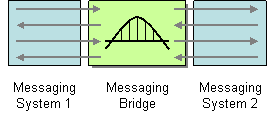An enterprise is using Messaging to enable applications to communicate. However, the enterprise uses more than one messaging system, which confuses the issue of which messaging system an application should connect to.
How can multiple messaging systems be connected so that messages available on one are also available on the others?

Use a Messaging Bridge, a connection between messaging systems, to replicate messages between systems.
Typically, there is no practical way to connect two complete messaging systems, so instead we connect individual, corresponding channels between the messaging systems. The Messaging Bridge is a set of Channel Adapters, where the non-messaging client is a actually another messaging system, and where each pair of adapters connects a pair of corresponding channels. The bridge acts as map from one set of channels to the other, and also transforms the message format of one system to the other. The connected channels may be used to transmit messages between traditional clients of the messaging system, or strictly for messages intended for other messaging systems.
... Read the entire pattern in the book Enterprise Integration Patterns
Related patterns:
Channel Adapter, Emerging Standards and Futures in Enterprise Integration, Message Channel, Message Endpoint, Messaging





